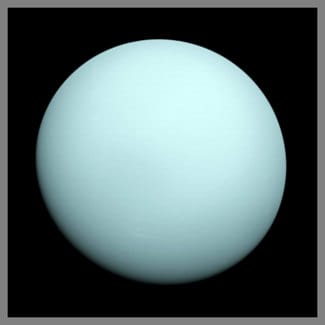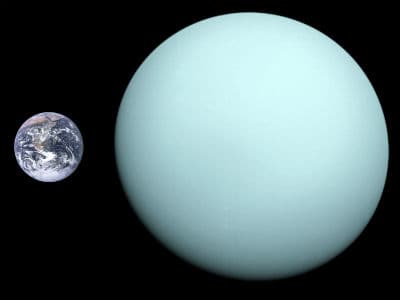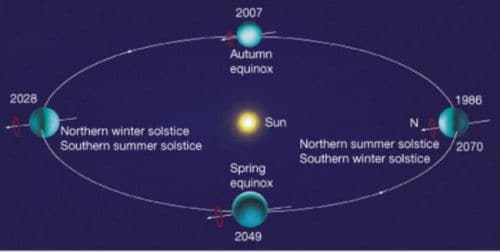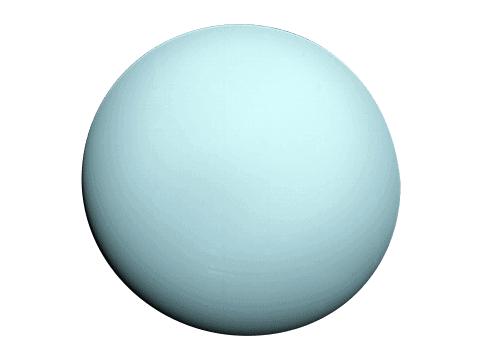Uranus is the seventh planet discovered in the Solar System that also led to the discovery of the last planet, Neptune they are both referred to as ice giants. Officially recognized in 1781 after many observations in the past, it is the third-largest planet of the Solar System.
Keys Facts & Summary
- Since ancient times it was not recognized due to its dimness and slow orbit. However, in 1781 Sir William Herschel announced its discovery being the first planet discovered with the help of a telescope.
- It was given the name Uranus, after the Greek god of the sky Ouranos.
- It is the only planet whose name is derived directly from a figure of Greek mythology.
- The mean apparent magnitude of Uranus is 5.68 with a standard deviation of 0.17, making it near the limit of naked eye visibility.
- Uranus is the seventh planet from the Sun, around 1.8 billion miles or 2.9 billion kilometers distance away. It has the third-largest planetary radius and fourth-largest mass in the Solar System.
- It has a radius of 25.362 kilometers or 15.759 miles, and has about 14.5 times the mass of Earth and four times its diameter – about 51.118 kilometers or 31.763 miles.
Uranus
Though it is visible to the naked eye, Uranus escaped clear classification for decades. Generally mistaken for a star, it is speculated that Hipparchos might have recorded it first in 128 BC in his star catalogue. Later it was incorporated into Ptolemy’s Almagest.

Although he first classified it as a comet, soon after reporting his discovery to other famous astronomers, it was concluded that in fact it was a planet. By 1783, Herschel acknowledged this and later was rewarded by the then king of England George III, on the condition that he moved to Windsor, in order for the royal family to also see it.
In other languages such as Chinese, Japanese, Korean and Vietnamese, Uranus is translated as “sky king star.” Its official name in Thai is Dao Yurenat, in Mongolian Tengeriin Van meaning “King of the Sky” but in Hawaiian its name is Hele’ekala, a loanword for the discoverer of Uranus, Herschel.
Formation
Through simulations after the Nice model, it has been suggested that both Uranus and Neptune formed closer to the sun and later drifted away. It is hypothesized that the Solar System formed from a giant rotating ball of gas and dust known as the pre-solar nebula. Much of it formed the Sun while more of its dust went on and merged to create the first proto-planets. As they grew, some accreted enough matter for their gravity to hold unto the nebula’s leftover gas. Estimates suggest the creation to have taken place about 4.5 billion years ago, and the drifting about 4 billion.
Distance, Size and Mass
Since its discovery, the planet has shifted it 1° west every 72 years however, its average distance from the sun still remains about 20 AU or 2 billion kilometers – 2 billion miles. The difference between its furthest and closest point from the sun is about 1.8 AU, larger than that of any other planet with the exception of the dwarf planet Pluto.

It has the third largest planetary radius: 25.362 kilometers or 15.759 miles, and its volume is about 63 times greater than Earth’s, which means that 63 Earths can fit inside it.
Orbit and Rotation
It takes Uranus about 7 years to pass through each zodiac constellation, and a total of 84 years to make a complete trip around the sun. Its interesting orbing caught the attention of astronomers because the planet escaped its predicted location, and thus it led to the discovery of the last planet in 1846 that would later be called Neptune.

Picture of Planet Uranus

Quick Facts
| Recorded By: | William Herschel |
| First Record: | March 13th 1781 |
| Surface Temperature: | -197 °C |
| Orbit Period: | (84.02 Earth years) |
| Orbit Distance: | 2,870,658,186 km |
| Notable Moons: | Oberon, Titania, Miranda, Ariel & Umbriel |
| Known Moons: | 27 |
| Equatorial Circumference: | 159,354 km |
| Polar Diameter: | 49,946 km |
| Equatorial Diameter: | 51,118 km |
| Mass: | (14.536 x Earth) |











